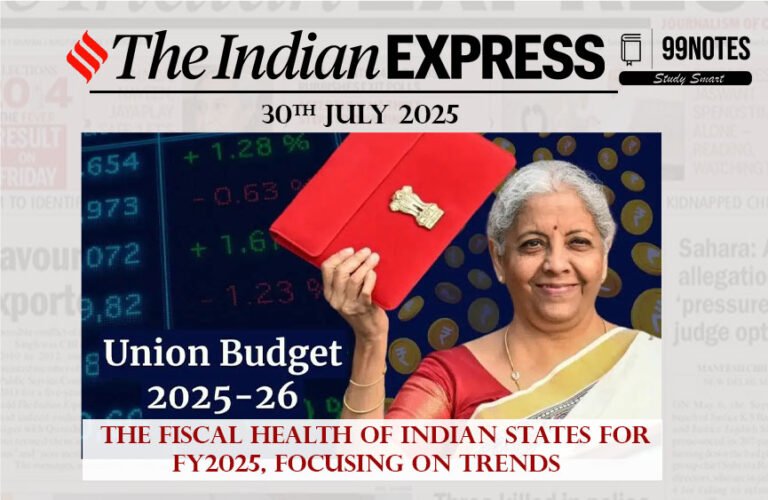15 Nov 2023 : Indian Express
Indian Express
15-November-2023
1) Arms and the Man and AI
Context:
- Both the military and the civilian sectors face difficulties with artificial intelligence (AI).
- Major powers are actively investing in AI for weapon systems, despite a widespread belief that harsh restrictions should be placed on the use of AI in military applications, particularly with regard to autonomous weapons that are not under human control.
- This discrepancy presents important questions, and India needs to carefully consider how to establish a national military policy for AI while also participating in global efforts to reduce the hazards associated with the technology.
UN Resolution on Autonomous Weapons:
- Concern over deadly autonomous weapons is growing, as evidenced by the recent vote in the UN General Assembly. The resolution, which was overwhelmingly approved, aims to address the problems that these kinds of weapons present.
- But the differences in the voting patterns of the main powers—China abstaining and the US and its allies supporting show the complexity of the situation.
- India’s vote against the resolution points to a complex position that needs more examination.
Developments in Major Powers:
- The US, China, and India are actively working on building autonomous weapons in addition to engaging in diplomatic posturing and participating in discussions on definitions, legitimacy, and negotiating venues.
- The US emphasizes the incorporation of AI into defense management through programs such as the Replicator.
- China uses its industrial capabilities for quick autonomous weapons manufacture, focusing on creating an “intelligentized” PLA.
US-China Dynamics and Asymmetric Strategy:
- While acknowledging China’s superior military might, the US is looking to innovate through autonomy powered by AI.
- In order to confront China’s increasing military might, the Replicator effort places a strong emphasis on deploying thousands of unmanned devices and relies on innovation.
- A key component of US strategy continues to be retaining human control over autonomous weapons, highlighting the necessity for commanders to use discretion.
India’s Pragmatic Approach:
- India’s UNGA vote in the negative indicates a shift toward pragmatism in its handling of international affairs.
- In the midst of China’s challenges and military imbalances, India understands the use of AI in defense planning.
- India’s rejection vote is in line with a reasonable approach to global governance, ethics, and national security, even though the country lags behind the US and China in military AI.
India’s Technological Partnership and National Capabilities:
- India and the US have a burgeoning technology alliance that requires significant investments in national capacities.
- India needs to concentrate on key AI sciences, technological capabilities, military doctrines, and institutions for efficient AI integration into defense administration if it wants to fully benefit from this partnership.
- Even with India’s advantages in AI, catching up to the big boys will take a large amount of capital and careful planning.
Way Forward:
- In the process of developing its own AI capabilities, India needs to continue its legacy of establishing global standards.
- Given India’s expanding technological capabilities, previous attempts in global control of emerging technologies can be increased.
- India can help shape responsible military AI use by partnering with like-minded nations and putting a focus on human involvement in autonomous weapon systems.
2) Nine things to do for clean air
Context:
- In India, air pollution ranks as the sixth leading cause of mortality, accounting for 1.6 million preventable deaths in 2019.
- This figure greatly exceeds the official tally of deaths during the pandemic linked to COVID-19.
- Poor air quality has an annual economic cost of almost Rs 7 lakh crore, which highlights the urgent need for a comprehensive approach.
Complexity of the Issue:
- Air pollution is a simple but intricate problem. It is a cross-border systemic issue with a variety of emission sources and linked economic variables.
- Disjointed approaches that focus on treating symptoms rather than the underlying causes, like construction bans or pollution towers, have not been demonstrated to be effective.
- Effective crisis management requires a coordinated strategy that tackles the root issues.
Recognizing Human-Induced Impact:
- The first step is to admit that air pollution is an issue that is caused by humans. Children, the elderly, rural populations, and the impoverished in urban areas are among the most susceptible groups, and they have made the least contribution to the issue.
- India’s reaction should be based on embracing evidence-based solutions and learning from other countries’ successful initiatives.
Coordinated Interventions for Success:
- A series of nine closely coordinated initiatives is suggested in order to reduce air pollution on a comprehensive level.
- These include:
- restricting emissions along the entire production-consumption-recycling value chain,
- cutting back on the burning of agricultural residue,
- improving accessible green urban public transportation,
- implementing widespread electrification,
- taking a regional or airshed approach,
- dealing with waste management and construction,
- enforcing laws consistently,
- raising public awareness through citizen mobilization,
- putting real-time monitoring systems in place.
Integrated Approach to Limit Emissions:
- It is imperative to adopt an integrated strategy that addresses emissions from industries, brick kilns, coal-fired power plants, and other types of household burning.
- In order to reduce indoor pollution, initiatives like the PM Ujjwala Yojana require ongoing assessment and development.
- Coordinated governance and logical cross-sectoral strategies are needed to address crop residue burning.
Affordable Green Urban Public Transport:
- To achieve widespread last-mile connection, there must be a significant increase in the supply of reasonably priced green urban public transportation.
- Urban air pollution can be considerably reduced by increasing metro ridership, enhancing bus services, restricting the increase of private vehicles, and taking inspiration from successful models in Singapore and Hong Kong.
Widespread Electrification:
- Building, vehicle, and industrial process electrification is essential, highlighting the need to move to renewable fuels.
- Nevertheless, this necessitates large expenditures for upgraded rail services and new infrastructure for electric charging.
- China is a prime example of how to successfully develop an effective land-based transportation system.
Regional or Airshed Approach:
- In order to address the sources of pollution in an area as a whole as opposed to just certain cities, a regional or airshed approach is essential.
- This strategy, which has been successfully applied in mega-urban areas like China, Mexico City, and Los Angeles, requires coordinated governance, which India finds difficult to achieve.
End-to-End Construction and Waste Management:
- An end-to-end strategy to waste management and building is essential to lowering the amount of dust and debris emitted into the air and water bodies.
- Reusing materials like stone, brick, and concrete as well as managing waste from construction and demolition projects can make a big difference in the quality of the air.
Legislation and Enforcement:
- It is essential to have strict laws and to enforce them consistently all year long and not just on special occasions like Diwali.
- The administration should not weaken environmental standards in response to pressure from special interest groups, and courts must continue to be resolute.
Citizen Mobilization and Education:
- It takes decades of widespread public mobilization for awareness and education to change people’s lifestyle choices.
- There is a need to reevaluate lifestyle choices and encourage sustainable living, taking inspiration from the successful experiences in Mexico City and Los Angeles.
Financial Support and Monitoring Systems:
- It is crucial to provide funding for coordinated efforts and to build local government capability.
- When it comes to funding climate change and air pollution reduction initiatives, the Sixteenth Finance Commission ought to take the lead set by the Fifteenth Finance Commission.
- To make well-informed decisions, real-time monitoring systems such as the SAFAR network need to be expanded and improved.
Way Forward:
- While putting these strategies into practice all at once may seem difficult, continuous improvement depends on them.
- Piecemeal tactics, modeled after places in China and Mexico City, should be avoided.
- Coordinated efforts help achieve urban climate and health goals at the same time as they combat air pollution. The choice is when to take these obvious actions.
For Enquiry

15 Nov 2023 : Indian Express

15 Nov 2023 : PIB

15 November 2023 : Daily Current Affairs

15 November 2023 : The Hindu Editorial Notes PDF

14 Nov 2023 : Daily Quiz

14 Nov 2023 : Daily Answer Writing

10 Nov 2023 : Daily Answer Writing

14 Nov 2023 : Indian Express

14 Nov 2023 : PIB

14 November 2023 : Daily Current Affairs
Indian Express 15 Nov 2023 : Indian Express Indian Express
14-November-2023
1) With a little help from the Sun
Context:
The emergence of clean energy…
November 2023 PIB 15 Nov 2023 : PIB PRESS INFORMATION BUREAU
15-November -2023
1. THE INDO-PACIFIC REGIONAL DIALOGUE 2023 (IPRD-2023)
Topic:…
Daily Current Affairs 15 November 2023 : Daily Current Affairs Daily Current Affairs
15-November-2023
1. Wholesale prices remain in deflation zone in Oct.
Topic:…
November 2023 The Hindu 15 November 2023 : The Hindu Editorial Notes PDF The Hindu Editorial
15-November-2023
1. A Norwegian perspective of India’s digital journey.
Topic:…
Daily Quiz 14 Nov 2023 : Daily Quiz 14 Nov 2023 : Daily Quiz…
mains answer writing 14 Nov 2023 : Daily Answer Writing Mains Answer Writing
14-November-2023
Q1) “The dynamics of center-state relations in recent times reflect…
mains answer writing 10 Nov 2023 : Daily Answer Writing Mains Answer Writing
10-November-2023
1. Any federal system is bound to have asymmetries, therefore…
Indian Express 14 Nov 2023 : Indian Express Indian Express
14-November-2023
1) With a little help from the Sun
Context:
The emergence of clean…
November 2023 PIB 14 Nov 2023 : PIB PRESS INFORMATION BUREAU
14-November -2023
1. ‘AAINA Dashboard for Cities’ portal launched.
Topic:…
Daily Current Affairs 14 November 2023 : Daily Current Affairs Daily Current Affairs
14-November-2023
1. Retail inflation eases to a four-month low of 4.87% in October.
Topic:…





